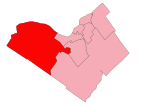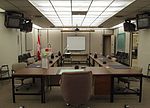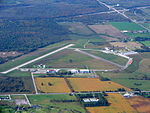Carp Hills

The Carp Hills (also known as Carp Ridge) are a small range of rocky hills between the shallow valleys of the Carp River and Constance Creek, entirely within the West Carleton-March Ward of Canada's capital, Ottawa, Ontario. It runs roughly from Kinburn Side Road southeast to the village of Carp and the South March Highlands at March Road.The hills cover roughly 4,000 hectares (10,000 acres) and are mostly undeveloped. The ridge is an extension of the Canadian Shield, with a landscape that is characterized by a mix of rocky outcrops, grassland, marshes, numerous shallow ponds, and patches of mature forest. Its pristine rugged nature has been compared to the nearby Gatineau Park and is regarded as an "ecological jewel".The Carp Ridge is used for hiking, hunting, cross-country skiing, and snowmobiling. Among the few walking and hiking trails on the ridge are the Carp Barrens Trail, a 3-kilometre (1.9 mi) trail south of Thomas Dolan Parkway, the Crazy Horse trail, a 6.2-kilometre (3.9 mi) loop trail starting at March Road, and pathways at Hidden Lake Park in the village of Carp.
Excerpt from the Wikipedia article Carp Hills (License: CC BY-SA 3.0, Authors, Images).Carp Hills
Carp Barrens Trail, Ottawa West Carleton-March (West Carleton)
Geographical coordinates (GPS) Address Nearby Places Show on map
Geographical coordinates (GPS)
| Latitude | Longitude |
|---|---|
| N 45.3806 ° | E -76.0686 ° |
Address
Carp Barrens Trail
Carp Barrens Trail
Ottawa, West Carleton-March (West Carleton)
Ontario, Canada
Open on Google Maps





